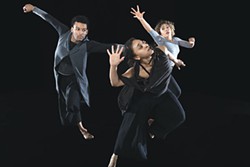Given Pittsburgh’s rich history of jazz, it’s perhaps fitting that the internationally acclaimed Urban Bush Women return with a program celebrating John William Coltrane. On their last visit, in 2008, UBW presented the Afrocentric Scales of Memory in collaboration with Senegal’s Compagnie Jant-Bi. With the 70-minute Walking With ’Trane (2015), March 11 at the August Wilson Center, the seven-member, New York-based company shows another side of itself, one more akin to how jazz musicians perform together and step out from the group to shine in improvised solos.
Co-choreographed by UBW founder/artistic director Jawole Willa Jo Zollar and associate artistic director/dancer Samantha Speis, the multi-styled dance work, presented by the Pittsburgh Dance Council, is performed in two “sides,” as with a record album.
“It isn’t about trying to imitate or be John Coltrane, but find the individual and collective voice inside him,” says Speis by phone from New York.
Set to an original electronic sound score by Phillip White that references Coltrane’s music, Side A, “JUST A CLOSER WALK WITH ’TRANE,” conjures the legendary saxophonist/composer’s essence. “It’s internal,” says Speis. “There are heightened solo states — cool and hot — in which the dancers riff to the blues, bebop, hard bop, gospel and free jazz.”
Side B, “FREED(OM),” with original music by composer/pianist George O. Caldwell played live, takes inspiration from Coltrane’s 1965 album A Love Supreme. Part 3 of that album, “Pursuance,” acted as a jumping off point for some of the movement, says Speis. “There is a lot of falling and diagonal pulls, with the dancers giving the impression of being in pursuit of something yet settled and content in what they are doing.”
In creating the work, Speis says she, Zollar, and the dancers researched Coltrane’s music, digging into it to explore how we hear music and are affected by it. One conclusion that they incorporated into the piece was “your body becomes the instrument and works in relationship to what you are hearing,” says Speis.
Whether or not you have a connection with Coltrane and his music, Walking With ‘Trane is sure to be a stroll worth experiencing.


